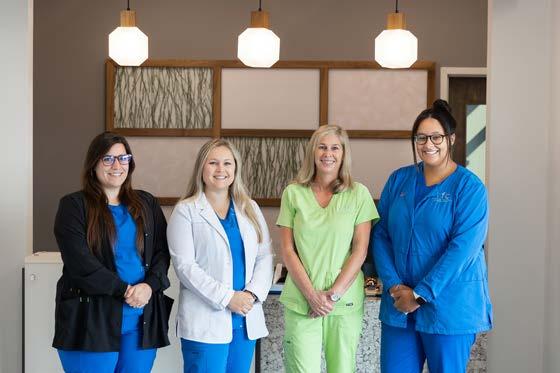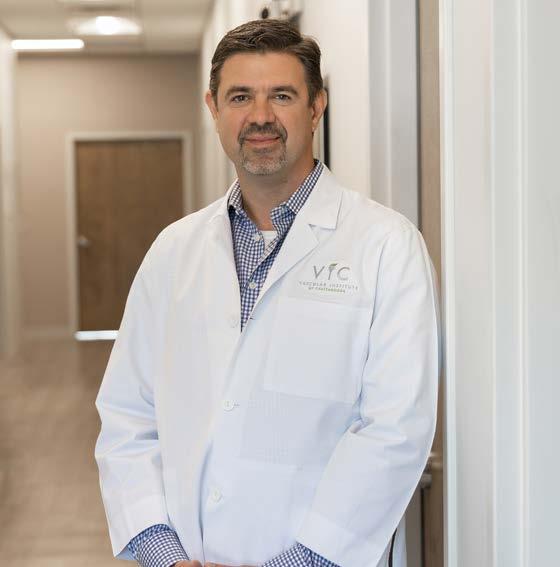
4 minute read
Vascular Institute of North Georgia
from September 2021
Saving Limbs and Restoring Lives: Why a Critical Limb Center is a Necessity for Every Community
The Southeast region of the United States has a high density of patients suffering from cardiovascular diseases, leading to heart attacks, strokes, or lower extremity “leg attacks” and amputations. This devastating outcome can leave patients with challenging and life-altering circumstances that could have been easily avoided by seeking a Critical Limb Ischemia (CLI) Specialist. Patients who have not managed their medical conditions well are at high risk, and amputation can often be the “simple solution” used by many surgeons to deal with the problem of gangrene. A CLI Specialist has many different tools and techniques to restore the blood flow to the lower leg, foot, and toes—preventing the need for amputation.
Advertisement
What is Peripheral Artery Disease (PAD)? When blood flow is blocked due to plaque build-up in the arteries, this condition can develop and lead to many complications. PAD often goes underdiagnosed, and when left untreated, can lead to painful walking, weak walking, numbness, open wounds with poor healing, or severe issues like stroke, heart attack, and sometimes even the loss of a limb from CLI—a lack of blood flow.
The Vascular Institute of Chattanooga is the first Critical Limb Center in the region, with its office-based interventional suites dedicated to Peripheral Vascular Disease Care and amputation prevention. The VIC vascular surgeons are nationally known for teaching—physicians from all over the country travel to learn new techniques, thus allowing them to provide better patient care and better outcomes for their patients. VIC has been successful with a rapid triage approach, focused diagnostic testing, and appropriate Interventional Therapy with a long view on aggressive risk factor modification—our overall 5-year limb salvage rate is 93%. This success can only be achieved with comprehensive support from primary care, podiatry, and area wound centers.
“Patients that are dealing with gangrene of the foot or nonhealing wounds (CLI) require prompt diagnosis, easy access to care, dedicated non-invasive ultrasound testing, and surgeons who have advanced vascular and endovascular techniques. Once diagnosed with CLI, our patients are treated with Interventional Care within one week to promote blood flow. This is the distinct difference from the inefficient traditional route to one that is navigated via a Critical Limb Center,” said Dr. Chris LeSar, Vascular Surgeon and CLI Specialist.
Vascular Surgical Care has changed over time, with an ever-evolving standard of care driven by the latest technologies and advances. For example, the newest testing that has advanced how we can perform an intervention is called Pedal Acceleration Time (PAT). This is a unique non-invasive

ultrasound approach of determining the blood flow in the foot, which allows the surgeons to target the arteries in the foot to re-establish the blood flow. When PAT Revascularization is successful, often the leg, foot, and toes can be saved.
When a patient turns to the Vascular Institute and engages our team, the first step they will go through is a clinical assessment. Then, a non-invasive ultrasound test is ordered which measures and compares the blood pressures in the legs and arms, blood flow throughout the legs, and a PAT assessment of the feet. Next, a provider sees the patient and reviews the medical assessment and ultrasound test to determine if an intervention is needed. When CLI is determined, patients are often scheduled within one week for an intervention or surgery. This timely process, advanced diagnostics, and rapid intervention leads to success and limb salvage for CLI patients. The key to the proper medical management of CLI patients often requires input from primary care, podiatry, regional wound centers, and other needed specialties. This robust network of medical providers works together to maintain the continuity of care and general wellbeing of the patient.
A community with an established program and an active CLI Center can offer the coordinated care that CLI patients need. This allows for issues to be addressed in a timelier fashion, resulting in a healthier population. However, unnecessary amputations of the legs continue to occur at a high rate in communities with racial disparity of care, socio-economic poverty, and harsh work environments. These factors can ultimately affect the patient’s limb salvage rate and mortality rate. We can shift away from this devastating outcome into life-renewing health through education and awareness of CLI disease state and the improved treatment options.
Who is at risk? The population with the following risk factors is most likely to be in the at-risk category: • Over the age of 50 • Uncontrolled diabetes • History of smoking • High cholesterol • High Blood Pressure
If these risk factors apply to you, consider the signs and symptoms of what to look for in a patient suffering from PAD. Many people with PAD can have vague symptoms or attribute their symptoms to something else, such as aging. If you are experiencing painful muscle cramping in the legs when you are walking or being active, and the pain stops with rest and resumes with activity, be evaluated. Becoming aware of your signs and symptoms is the first critical piece to the puzzle. A simple way to remember these symptoms is the word FLOW: Feeling of pain in the legs, Loss of sensation, Open sores that will not heal, and Weakness when walking. If you are having these problems, see your primary care provider.
Vascular Institute has grown over the last six years and now has three locations serving Chattanooga, Cleveland, and North Georgia. Our staff of almost 100 members is dedicated to changing the way Vascular Care is delivered in our region. A patient with an early diagnosis and an active treatment plan can achieve a successful outcome and victory over amputation. Know more—no more amputation!












